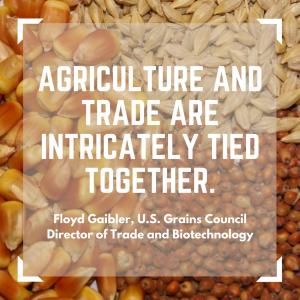When trade policy works, the world wins. But how does trade policy happen?
In a new, four-part audio series, the U.S. Grains Council (USGC) tackles this question as well as explaining why trade policy matters to U.S. agriculture, how trade negotiations work and why developing and expanding markets for U.S. coarse grains and co-products would not be possible without strong trade policy.
“We always say that U.S. farmers are some of the most international of all the business people in the United States because of the global impact of what they do and what happens around the world that impacts them,” said Tom Sleight, USGC president and chief executive officer, in one of the audio updates. “All of these things come together and have an impact on trade and prices, and farmers need to factor in all of these issues.”
As U.S. farmers continue to increase their own productivity, exports are ever-increasing in importance to the farm economy. Farmers need to find more demand for their bountiful harvests – and trade can help make that happen.
“That is going to be the determining factor of if U.S. agriculture is going to remain competitive and financially viable in the future,” said Floyd Gaibler, USGC director of trade and biotechnology, in another part of the audio series. “It really does come down to the fact that if we cannot continue to expand our ability to export, the continued growth and productivity of this sector will decline, which means less economic opportunity for the sector as a whole.”
In order to develop the markets that grow into long-term customers of U.S. agriculture, the market must first be accessible – and that requires trade policy work.
“In terms of tariff or non-tariff trade barriers being broken down and removed, you have to have that market access to allow your products to compete in a marketplace,” Sleight said. “And so trade policy creates that market access that then allows you to go in and develop a market for the product.”
These trade policy discussions can involve single issues or larger trade agreements, like the North American Free Trade Agreement (NAFTA) negotiating round happening this week. Gaibler outlines in the audio series how these trade agreement negotiations happen – a long and laborious process, but one crucial to maintaining existing market access and creating new opportunities for U.S. agriculture and their international customers.
“There are goals to try and have these issues resolved as soon as possible, but in most cases, these are years-long processes,” Gaibler said. “It is always a difficult process to get through because everybody has the same vested interest in trying to benefit their citizens and commerce in their respective countries.”
“Good policy takes time and you have to work hard to achieve it.”
Learn more about how trade policy works in the Council’s four-part audio series:
- Why Farmers Should Track Trade Policy with Tom Sleight, USGC President and CEO
- How Trade Underpins The Bottomline with Floyd Gaibler, USGC Director of Trade and Biotechnology
- What Happens During A Trade Negotiation with Floyd Gaibler, USGC Director of Trade and Biotechnology
- How Trade Policy Makes Market Development Possible with Tom Sleight, USGC President and CEO


